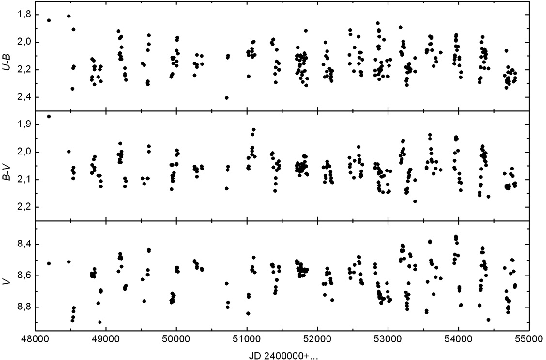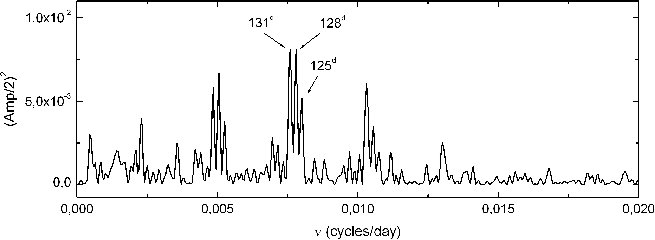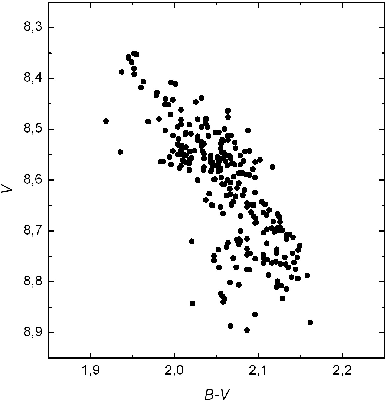|
Peremennye Zvezdy (Variable Stars) 29, No. 1, 2009 Received 24 September; accepted 20 October.
|
Article in PDF |
Photometry of the Post-AGB Star IRAS 22272+5435=V354 Lac in 1990-2008
V. P. Arkhipova, N. P. Ikonnikova, G. V. Komissarova
Sternberg Astronomical Institute, University Ave. 13, 119992 Moscow, Russia
|
New
|
1. INTRODUCTION
The IR source IRAS 22272+5435 is identified with the bright star
BD+54![]() 2787
2787 ![]()
HD 235858 (22![]() 29
29![]() 10
10![]() 4 +54
4 +54![]() 51
51![]() 06
06
![]() , 2000). It is one of the most reliable protoplanetary
nebula candidates.
, 2000). It is one of the most reliable protoplanetary
nebula candidates.
The spectral energy distribution of IRAS 22272+5435 shows a characteristic double peak, with about the same amounts of energy emitted in the visible plus near-infrared (from the reddened photosphere) and in the mid-infrared (re-emission from circumstellar dust) (Hrivnak and Kwok 1991).
The chemical composition of IRAS 22272+5435 is typical of carbon
post-AGB stars. Zacs, Klochkova, and Panchuk (1995) found the
star to be iron poor: [Fe/H]![]() . The elements of the
. The elements of the
![]() -process are overabundant relative to the solar
composition, and the carbon abundance is C/O
-process are overabundant relative to the solar
composition, and the carbon abundance is C/O![]() 12. In the
spectra of IRAS 22272+5435, strong molecular bands of C
12. In the
spectra of IRAS 22272+5435, strong molecular bands of C![]() and
C
and
C![]() are found (Hrivnak and Kwok 1991).
are found (Hrivnak and Kwok 1991).
In the survey of protoplanetary nebula candidates with the Hubble Space Telescope, Ueta et al. (2000) discovered an elongated low-surface-brightness reflection nebulosity around IRAS 22272+5435. These authors believe that a multilobed nebula may be a progenitor of a complex planetary nebula.
The spectral classification of V354 Lac is a difficult problem
because of its peculiar spectrum. In the HD catalog, HD 235858 has
the spectral type K5. McCuskey (1955) classified the object as
M0III and Hrivnak and Kwok (1991), as GpIa. The atmospheric
parameters of IRAS 22272+5435, ![]() K and
K and ![]() ,
correspond to a G2 supergiant (Zacs, Klochkova, and Panchuk
1995).
,
correspond to a G2 supergiant (Zacs, Klochkova, and Panchuk
1995).
The brightness variability of BD+54![]() 2787 was discovered by
Strohmeier and Knigge (1960). They list it as a possible
short-period variable with an amplitude of 0
2787 was discovered by
Strohmeier and Knigge (1960). They list it as a possible
short-period variable with an amplitude of 0![]() 5. Filatov (1961)
reported irregular variability of the star with an amplitude of
1
5. Filatov (1961)
reported irregular variability of the star with an amplitude of
1![]() 5-2
5-2![]() 0. In the 62nd GCVS Name-List (Kukarkin et al. 1977),
BD+54
0. In the 62nd GCVS Name-List (Kukarkin et al. 1977),
BD+54![]() 2787 got the designation V354 Lac. The GCVS variability
type currently listed for the star is LB (a slow irregular
variable).
2787 got the designation V354 Lac. The GCVS variability
type currently listed for the star is LB (a slow irregular
variable).
| JD | |
|
|
JD | |
|
|
JD | |
|
|
| 245... | 245... | 245... | |||||||||
| 1708 | 8.506 | 2.049 | 2.101 | 2621 | 8.643 | 2.070 | 2.220 | 3622 | 8.528 | 2.035 | 2.059 |
| 1709 | 8.513 | 2.068 | 2.124 | 2635 | 8.650 | 2.045 | 2.128 | 3648 | 8.720 | 2.078 | 2.175 |
| 1710 | 8.523 | 2.058 | 2.225 | 2817 | 8.546 | 2.059 | 2.242 | 3676 | 8.608 | 2.060 | 2.115 |
| 1721 | 8.513 | 2.040 | 2.039 | 2820 | 8.527 | 2.056 | 2.206 | 3685 | 8.548 | 2.035 | 2.142 |
| 1724 | 8.521 | 2.064 | 2.097 | 2824 | 8.583 | 2.043 | 2.129 | 3748 | 8.617 | 2.066 | 2.076 |
| 1728 | 8.553 | 2.066 | 2.217 | 2857 | 8.649 | 2.044 | 1.863 | 3942 | 8.521 | 2.057 | 2.158 |
| 1734 | 8.566 | 2.045 | 2.204 | 2860 | 8.665 | 2.058 | 2.031 | 3946 | 8.496 | 2.032 | 2.129 |
| 1751 | 8.589 | 2.085 | 2.175 | 2866 | 8.668 | 2.110 | 2.234 | 3948 | 8.495 | 2.004 | 2.096 |
| 1752 | 8.605 | 2.067 | 2.132 | 2869 | 8.716 | 2.133 | 2.200 | 3950 | 8.464 | 2.063 | 2.108 |
| 1752 | 8.594 | 2.071 | 2.101 | 2870 | 8.700 | 2.078 | 1.911 | 3963 | 8.368 | 1.949 | 2.029 |
| 1754 | 8.569 | 2.072 | 2.163 | 2871 | 8.717 | 2.075 | 1.918 | 3964 | 8.351 | 1.952 | 1.982 |
| 1763 | 8.546 | 2.057 | 2.262 | 2872 | 8.708 | 2.133 | 2.049 | 3965 | 8.360 | 1.945 | 1.990 |
| 1766 | 8.538 | 2.055 | 2.097 | 2873 | 8.716 | 2.077 | 2.030 | 3966 | 8.353 | 1.955 | 1.957 |
| 1768 | 8.528 | 2.055 | 2.100 | 2874 | 8.736 | 2.122 | 2.270 | 3967 | 8.358 | 1.945 | 1.949 |
| 1778 | 8.571 | 2.063 | 2.105 | 2875 | 8.723 | 2.064 | 1.962 | 3978 | 8.391 | 1.952 | 2.058 |
| 1780 | 8.565 | 2.043 | 2.113 | 2882 | 8.744 | 2.140 | 2.217 | 3991 | 8.471 | 1.995 | 2.031 |
| 1781 | 8.567 | 2.069 | 2.220 | 2890 | 8.721 | 2.076 | 2.189 | 4011 | 8.671 | 2.078 | 2.112 |
| 1782 | 8.558 | 2.052 | 2.239 | 2903 | 8.776 | 2.089 | 2.149 | 4013 | 8.683 | 2.097 | 2.170 |
| 1791 | 8.600 | 2.063 | 2.291 | 2905 | 8.771 | 2.074 | 2.202 | 4014 | 8.697 | 2.110 | 2.123 |
| 1806 | 8.598 | 2.047 | 2.156 | 2915 | 8.744 | 2.090 | 2.175 | 4029 | 8.791 | 2.139 | 2.257 |
| 1810 | 8.565 | 2.014 | 2.117 | 2930 | 8.752 | 2.146 | 2.248 | 4036 | 8.787 | 2.112 | 2.220 |
| 1810 | 8.567 | 2.018 | 2.134 | 2944 | 8.747 | 2.086 | 1.983 | 4298 | 8.787 | 2.158 | 2.292 |
| 1816 | 8.561 | 2.018 | 2.080 | 2984 | 8.649 | 2.068 | 2.136 | 4301 | 8.793 | 2.147 | 2.270 |
| 1820 | 8.568 | 2.052 | 2.209 | 2996 | 8.702 | 2.119 | 2.248 | 4316 | 8.693 | 2.124 | 2.183 |
| 1822 | 8.574 | 2.035 | 2.118 | 3003 | 8.737 | 2.147 | 2.251 | 4317 | 8.682 | 2.118 | 2.261 |
| 1822 | 8.561 | 2.054 | 2.091 | 3015 | 8.762 | 2.142 | 2.171 | 4319 | 8.663 | 2.091 | 2.184 |
| 1834 | 8.564 | 2.018 | 1.916 | 3032 | 8.754 | 2.070 | 2.128 | 4322 | 8.630 | 2.062 | 2.108 |
| 1840 | 8.572 | 2.051 | 2.116 | 3176 | 8.507 | 2.014 | 1.891 | 4328 | 8.535 | 2.014 | 2.000 |
| 1843 | 8.570 | 2.078 | 2.314 | 3182 | 8.495 | 2.039 | 2.072 | 4332 | 8.451 | 1.988 | 2.047 |
| 1853 | 8.562 | 2.082 | 2.266 | 3193 | 8.439 | 2.032 | 2.078 | 4342 | 8.427 | 1.980 | 1.964 |
| 2086 | 8.653 | 2.055 | 2.162 | 3196 | 8.446 | 2.026 | 2.095 | 4349 | 8.452 | 1.993 | 2.074 |
| 2106 | 8.724 | 2.110 | 2.254 | 3202 | 8.411 | 2.001 | 2.080 | 4363 | 8.509 | 2.020 | 2.144 |
| 2112 | 8.653 | 2.086 | 2.003 | 3205 | 8.408 | 1.996 | 2.091 | 4369 | 8.532 | 2.005 | 2.189 |
| 2119 | 8.650 | 2.094 | 2.101 | 3212 | 8.406 | 1.963 | 2.031 | 4370 | 8.525 | 2.032 | 2.051 |
| 2132 | 8.581 | 2.053 | 2.108 | 3216 | 8.418 | 1.960 | 1.994 | 4372 | 8.551 | 2.014 | 2.079 |
| 2133 | 8.595 | 2.056 | 2.214 | 3223 | 8.440 | 1.989 | 2.045 | 4374 | 8.544 | 2.019 | 2.103 |
| 2137 | 8.580 | 2.034 | 2.068 | 3230 | 8.491 | 2.008 | 2.038 | 4385 | 8.550 | 2.004 | 2.116 |
| 2138 | 8.554 | 2.051 | 2.247 | 3255 | 8.707 | 2.137 | 2.182 | 4386 | 8.558 | 2.035 | 2.068 |
| 2142 | 8.556 | 2.043 | 2.117 | 3261 | 8.729 | 2.149 | 2.283 | 4393 | 8.598 | 2.048 | 2.088 |
| 2172 | 8.583 | 2.052 | 2.194 | 3268 | 8.775 | 2.144 | 2.313 | 4426 | 8.880 | 2.162 | 2.192 |
| 2186 | 8.619 | 2.083 | 2.204 | 3270 | 8.793 | 2.146 | 2.265 | 4654 | 8.552 | 2.078 | 2.245 |
| 2187 | 8.632 | 2.077 | 2.262 | 3273 | 8.814 | 2.133 | 2.222 | 4676 | 8.699 | 2.128 | 2.331 |
| 2192 | 8.643 | 2.104 | 2.231 | 3283 | 8.747 | 2.106 | 2.191 | 4677 | 8.699 | 2.125 | 2.063 |
| 2196 | 8.648 | 2.094 | 2.250 | 3291 | 8.722 | 2.077 | 2.179 | 4682 | 8.743 | 2.122 | 2.282 |
| 2199 | 8.647 | 2.108 | 2.284 | 3292 | 8.649 | 2.092 | 2.159 | 4686 | 8.751 | 2.131 | 2.294 |
| 2210 | 8.756 | 2.111 | 2.210 | 3304 | 8.543 | 2.084 | 2.157 | 4696 | 8.808 | 2.128 | 2.262 |
| 2454 | 8.557 | 2.021 | 2.092 | 3305 | 8.537 | 2.073 | 2.214 | 4700 | 8.833 | 2.128 | 2.220 |
| 2460 | 8.581 | 2.054 | 2.157 | 3313 | 8.463 | 2.064 | 2.215 | 4703 | 8.810 | 2.122 | 2.181 |
| 2462 | 8.580 | 2.044 | 1.911 | 3320 | 8.476 | 2.064 | 2.196 | 4705 | 8.799 | 2.123 | 2.270 |
| 2470 | 8.615 | 2.075 | 1.943 | 3383 | 8.535 | 2.180 | 2.115 | 4714 | 8.765 | 2.132 | 2.261 |
| 2518 | 8.579 | 2.093 | 2.211 | 3384 | 8.560 | 2.102 | 2.214 | 4715 | 8.765 | 2.127 | 2.286 |
| 2528 | 8.533 | 2.032 | 2.040 | 3547 | 8.833 | 2.060 | 2.060 | 4717 | 8.760 | 2.121 | 2.305 |
| 2586 | 8.480 | 1.981 | 1.960 | 3548 | 8.823 | 2.055 | 2.075 | 4742 | 8.586 | 2.080 | 2.228 |
| 2587 | 8.510 | 2.013 | 2.157 | 3563 | 8.639 | 2.037 | 2.059 | 4761 | 8.499 | 2.060 | 2.205 |
| 2595 | 8.481 | 2.037 | 2.114 | 3593 | 8.380 | 1.952 | 2.016 | 4768 | 8.502 | 2.087 | 2.205 |
| 2597 | 8.521 | 2.028 | 2.076 | 3595 | 8.388 | 1.937 | 1.958 | 4783 | 8.574 | 2.117 | 2.288 |
| 2613 | 8.590 | 2.089 | 2.217 | 3610 | 8.502 | 1.989 | 2.012 | 4799 | 8.672 | 2.125 | 2.282 |
| 2618 | 8.630 | 2.082 | 2.076 | 3614 | 8.519 | 2.005 | 1.971 | 4801 | 8.659 | 2.113 | 2.225 |
| 2620 | 8.645 | 2.086 | 2.242 | 3616 | 8.514 | 2.028 | 1.964 | 4802 | 8.667 | 2.123 | 2.261 |
The light-curve and radial-velocity studies of V354 Lac were
carried out by Hrivnak and Lu (2000) respectively in 1994-1996
and 1991-1995. They found brightness and radial-velocity
variability with the period
![]() .
.
The radial-velocity monitoring of V354 Lac performed by Zacs
et al. (2009) confirmed regular variations with a peak-to-peak
amplitude of about 10 km s![]() and a period of about 131.2
days.
and a period of about 131.2
days.
2. OBSERVATIONS OF V354 Lac
Our ![]() photometry of IRAS 22272+5435 was performed in
1990-2008 with the 0.6-m telescope of the Crimean Station of the
Sternberg Astronomical Institute. The measurements were obtained
using a pulse-counting photometer with an EMI 9789 photomultiplier
and a filter set consistent with the Johnson system. All
observations were made with respect of the comparison star
BD+54
photometry of IRAS 22272+5435 was performed in
1990-2008 with the 0.6-m telescope of the Crimean Station of the
Sternberg Astronomical Institute. The measurements were obtained
using a pulse-counting photometer with an EMI 9789 photomultiplier
and a filter set consistent with the Johnson system. All
observations were made with respect of the comparison star
BD+54![]() 2793 (
2793 (![]() ,
,
![]() ,
,
![]() ). The
typical photometric uncertainties range from 0
). The
typical photometric uncertainties range from 0![]() 01 in the
01 in the
![]() band to 0
band to 0![]() 05 in the
05 in the ![]() band. The observations obtained in
1990-1999 were published earlier (Arkhipova et al. 1993 and
Arkhipova et al. 2000). The
band. The observations obtained in
1990-1999 were published earlier (Arkhipova et al. 1993 and
Arkhipova et al. 2000). The ![]() photometry performed after 1999
is listed in Table 1. The light and color curves of V354 Lac for
1990-2008 are presented in Fig. 1.
photometry performed after 1999
is listed in Table 1. The light and color curves of V354 Lac for
1990-2008 are presented in Fig. 1.
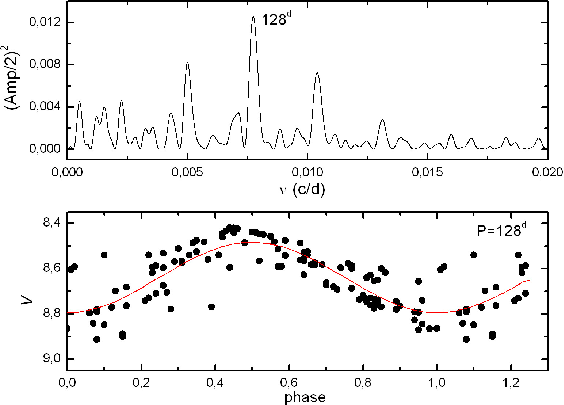 |
Fig. 3.
The power spectra (top panel) and the
phased |
During our observations, V354 Lac showed semi-regular brightness
variations with varying amplitudes. Its largest amplitudes do not
exceed
![]() ,
,
![]() ,
,
![]() .
.
We searched for periodicity in the observations obtained in 1990-2008 using the DFT (Discrete Fourier Transforms) package by Dr. V.M. Lyuty.
In the power spectrum (Fig. 2), triplet frequencies are
dominating:
![]() ,
,
![]() ,
,
![]() . The ratios
. The ratios
![]() and
and
![]() are close to 1.024. The periods
are close to 1.024. The periods
![]() and
and
![]() have
approximately the same amplitudes, about
have
approximately the same amplitudes, about
![]() in the
in the
![]() band.
band.
A single period, ![]() days, was found in the observations
of 2000-2008. The corresponding power spectra and the
days, was found in the observations
of 2000-2008. The corresponding power spectra and the ![]() -band
phased light curve are shown in Fig. 3.
-band
phased light curve are shown in Fig. 3.
 |
Fig. 4.
The radial-velocity variations of V354 Lac
(black filled circles) with a sinusoid fit ( |
Considering the radial-velocity variations (Zacs et al., 2009) together with our light curve (Fig. 4) confirms the conclusion of Hrivnak and Lu (2000) that V354 Lac "is brightest when it is at its average size and expanding and faintest when at its average size and contracting". Hrivnak and Lu interpreted this variability as due to pulsation in the star rather than to its binary nature.
The ![]() diagram shows a clear correlation: the star is
generally bluer when brighter (Fig. 5).
diagram shows a clear correlation: the star is
generally bluer when brighter (Fig. 5).
V354 Lac is located at a low galactic latitude
(![]() ).
The interstellar extinction in the direction of V354 Lac from maps
of Neckel and Klare (1980) is
).
The interstellar extinction in the direction of V354 Lac from maps
of Neckel and Klare (1980) is
![]() at
at
![]() kpc. From
kpc. From ![]() data, we conclude that
data, we conclude that ![]() and
and
![]() . Thus, practically all the color excess can be
caused by interstellar extinction.
. Thus, practically all the color excess can be
caused by interstellar extinction.
In the ![]() -
-![]() two-color diagram (Fig.6), the star moves
along the sequence of supergiants in the course of its
fluctuations. Correction of the color indices for reddening with
two-color diagram (Fig.6), the star moves
along the sequence of supergiants in the course of its
fluctuations. Correction of the color indices for reddening with
![]() puts the star on the sequence of supergiants, where
the spectral type of the star varies during pulsations from K1 to
K7.
puts the star on the sequence of supergiants, where
the spectral type of the star varies during pulsations from K1 to
K7.
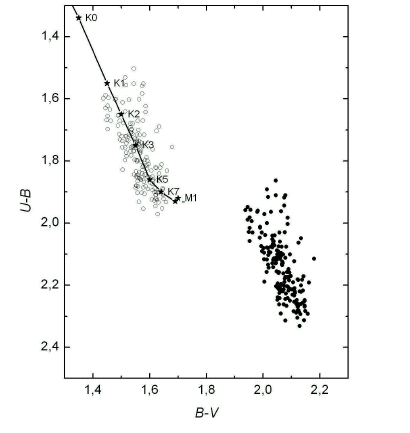 |
Fig. 6.
V354 Lac in the |
3. Conclusions
Our long-term ![]() photometry of the post-AGB star V354 Lac
permitted to study its variability character. V354 Lac showed
semi-regular light variations with varying amplitudes. The maximal
amplitudes did not exceed:
photometry of the post-AGB star V354 Lac
permitted to study its variability character. V354 Lac showed
semi-regular light variations with varying amplitudes. The maximal
amplitudes did not exceed:
![]() ,
,
![]() ,
,
![]() . The observed behavior of V354 Lac is explained
with beating of two closely spaced pulsation modes with the period
ratio 1.02. The other post-AGB stars with amplitude modulation are
IRAS 19386+0155
. The observed behavior of V354 Lac is explained
with beating of two closely spaced pulsation modes with the period
ratio 1.02. The other post-AGB stars with amplitude modulation are
IRAS 19386+0155![]() V1648 Aql (Arkhipova et al. 2009) and IRAS
08544-4431 (Kiss et al. 2007). The period ratio for them is 1.04.
Some pulsating red variables on the asymptotic giant branch (AGB)
show pulsations with two close periods. Such a phenomenon is
detected, for example, for RX UMa and RY Leo (Kiss et al. 2000).
The authors of the cited paper assumed that the period ratios
found for these stars (1.03-1.10) suggested either high-order
overtone or radialnon-radial oscillation.
V1648 Aql (Arkhipova et al. 2009) and IRAS
08544-4431 (Kiss et al. 2007). The period ratio for them is 1.04.
Some pulsating red variables on the asymptotic giant branch (AGB)
show pulsations with two close periods. Such a phenomenon is
detected, for example, for RX UMa and RY Leo (Kiss et al. 2000).
The authors of the cited paper assumed that the period ratios
found for these stars (1.03-1.10) suggested either high-order
overtone or radialnon-radial oscillation.
The mean ![]() parameters of V354 Lac have not changed during the
past 19 years:
parameters of V354 Lac have not changed during the
past 19 years:
![]() ,
,
![]() ,
and
,
and
![]() .
.
The brightness and the colors change in phase: the star is generally bluer when brighter. The temperature variations during pulsations correspond to the changes of the spectral type between K1 and K7.
Acknowledgements: This study was partly supported by the Council for the Program of Support for Leading Scientific Schools (project NSh.433.2008.2).
References:
Arkhipova, V.P., Ikonnikova, N.P., Noskova, R.I., 1993, Astronomy Letters, 19, 169
Arkhipova, V.P., Ikonnikova, N.P., Noskova, R.I., et al., 2000, Astron. Lett., 26, 609
Arkhipova, V.P., Ikonnikova, N.P., Komissarova, G.V., 2009, Astronomy Letters (in press)
Filatov, G.S., 1961, Astron. Tsirk., No. 223
Hrivnak, B.J. and Kwok, S., 1991, Astrophys. J., 371, 631
Hrivnak, B.J. and Lu, W.X., 2000, The Carbon Star Phenomenon. IAU Symp. 177 (Ed. R. F. Wing, Dordrecht: Kluwer Acad. Publ.), p. 293
Kiss, L.L., Szatmáry, K., Szabó, G. and Mattei, J.A., 2000, Astron. Astrophys., Suppl. Ser., 145, 283
Kiss, L.L., Derekas, A., Szabó, G.M., et al., 2007, MNRAS, 375, 1338
Kukarkin, B.V., Kholopov, P.N., Fedorovich V.P., et al., 1977, Inform. Bull. Var. Stars, No. 1248, 1
Neckel, Th. and Klare, G., 1980, Astron. Astrophys., Suppl. Ser., 42, 251
Straizys, V.L., 1977, Multicolor Stellar Photometry (Mokslas: Vilnius)
Strohmeier, W., Knigge, R., 1960, Veröff. Remeis-Sternwarte Bamberg, 5, No. 5, 1
Ueta, T., Meixner, M. and Bobrowsky, M., 2000, Astrophys. J., 528, 861
Zacs, L., Klochkova, V.G., and Panchuk, V.E., 1995, MNRAS, 275, 764
Zacs, L., Sperauskas, J., Musaev, F.A., et al., 2009, Astrophys. J., 695, 203
